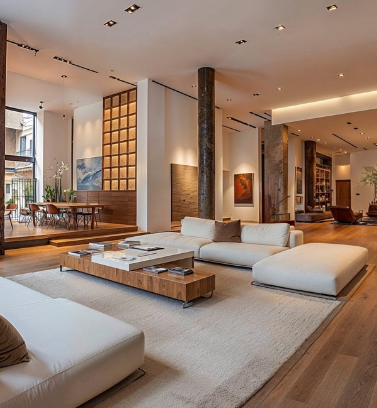Table of Contents
Key Takeaways
- Loft living merges generous open spaces with an urban character, appealing to individuals who value flexibility, creativity, and city energy.
- Strategic design techniques, such as layering, multi-use furniture, and careful lighting, let you transform open floor plans into comfortable and highly functional spaces.
- Daylight is plentiful in lofts, and optimizing light can make a space feel bigger, more inviting, and more conducive to well-being.
- Loft complexes foster community, offering shared amenities and opportunities to connect with neighbors.
- Trends in urban loft housing reflect the growing popularity of adaptable, city-based living arrangements in today’s housing market.
- Carefully weighing the pros and cons of loft living will help you make an informed decision before signing a lease or buying your next home.
What Makes Loft Living So Appealing?
Loft living has become increasingly popular, especially among urban dwellers who appreciate open spaces, high ceilings, and a blend of industrial and modern design. Originally converted from old warehouses and factories, lofts offer a unique architectural charm with exposed brick, large windows, and open floor plans that encourage creativity in layout and design. This type of living appeals to those seeking a minimalist yet sophisticated lifestyle, where function and form coexist. The spaciousness also allows multipurpose use, and it is ideal for working from home, entertaining, or even setting up a small studio or creative workspace.
The appeal goes beyond aesthetics. Many modern lofts are in revitalized city neighborhoods, offering walkability, cultural experiences, and a strong sense of community. For example, North Loop luxury lofts exemplify how this style of living blends historic character with modern convenience, often situated close to shops, restaurants, and public transportation. In such areas, residents enjoy the vibrancy of city life while retreating to a space that feels open and personalized. The lifestyle benefits and design flexibility make loft living not just a trend, but a thoughtful choice for those who value urban energy and interior adaptability.
Benefits of Open-Concept Spaces
The expansive, open floor plans of lofts set the stage for unparalleled versatility. Instead of feeling boxed in, you’re embraced by broad sightlines, uninterrupted wall space, and an atmosphere that encourages creativity and collaboration. This openness is perfect for those who love to entertain, as the flow from kitchen to living room encourages mingling and socializing without barriers. Lofts are also ideal for working from home, making reconfiguring living and work spaces easy.
The abundance of natural light in these open spaces is key to their enduring appeal. Streaming unimpeded through expansive glass, sunlight shapes your daily routines and impacts emotional well-being. Studies report that increased access to daylight enhances productivity, reduces eye strain, and improves sleep quality. This preference for open, luminous residences is shaping development priorities in cities nationwide, as people prioritize comfort, mental health, and energy efficiency in choosing where to live.
Loft dwellers also benefit from lower utility costs, thanks to the energy-saving properties of abundant natural light. By harnessing sunlight, lofts can reduce the need for artificial lighting during the day, leading to environmental benefits and significant financial savings over time.
Creative Design Ideas for Lofts
Designing a loft involves reinventing space. Rather than following fixed room layouts, you can create distinct “zones” that address everyday needs while maintaining an open atmosphere. Start by considering tall, open bookcases as partial dividers—they shape living areas while keeping light and air flow. Rolling islands or foldable dining tables in the kitchen can easily transition between meal prep, working from home, or socializing.
- Floor-to-ceiling shelving serves as both an architectural boundary and ample storage.
- Modular or stackable furniture pieces offer maximum flexibility and can be configured for different occasions or daily routines.
- Layered rugs add comfort, absorb sound, and help visually define space for lounging or dining.
- Large-format art and sculptural lighting enhance the height, connecting the heritage architecture to a modern edge.
- Vertical gardens bring natural beauty indoors, enhancing air quality and boosting the room’s vibrance without cluttering floors.
Many residents combine the industrial features of their lofts with comfortable, modern furnishings. They balance raw materials like brick, concrete, and steel with soft textiles, warm woods, and carefully selected decorative items. This combination reflects a unique story of the space and its inhabitants, transforming the home into a truly one-of-a-kind retreat in the city’s heart.
Maximizing Natural Light
Lofts tend to excel in sunlight exposure, but capitalizing on this requires a thoughtful approach. Light-reflective wall colors—crisp whites, soft neutrals, or gentle pastels—multiply available daylight. Consider using gauzy drapes, which soften yet don’t block light, and hanging mirrors to reflect rays further into darker corners or hallways. Open shelving or glass room dividers also prevent shadows from building up in interior zones.
Arranging your furniture to take advantage of sunlight can be transformative; position reading chairs or workspaces near windows to keep tasks well lit, or establish a dining area where sunset light can set the perfect mood. Experts also recommend uncluttered window sills to maximize glass exposure and using dimmable light fixtures to enhance ambiance as evening falls. The cumulative effect is a living space that feels bright, inviting, and organically connected to the changing light of the city beyond.
Ample daylight supports visual comfort, warmth, and overall wellness, boosting serotonin levels, aiding focus, and fostering calm. Especially in dense neighborhoods where outdoor escapes may be rare, the relationship between your loft’s interior and the natural cycles of day and night is an advantage not to be underestimated.
Addressing Common Challenges
For all their benefits, lofts do have a few quirks that require creative problem-solving. Without partitions, sound carries easily, making it important to offset hard surfaces with area rugs, plush furniture, or wall-mounted textiles. Textile elements can be stylish and effective at absorbing noise, reducing echo, and adding comfort to vast, echoing rooms.
Storage can also seem tricky initially, but built-ins along staircases, under elevated platforms, or in vertical wall niches can store books, clothes, and daily essentials while keeping floors open. Organized cabinetry, open shelving, and even hidden storage in ottomans or beds help minimize clutter, preserving the loft’s breezy, uncluttered feel.
Privacy is the third big challenge, especially for couples or roommates who share an open plan. Establishing separation with sliding doors, tall bookcases, curtain tracks, or clever movable panels can give you intimacy without sacrificing daylight or visual openness. The ability to customize and adapt your layout as your needs change is a defining feature of successful loft living.
Building Community in Urban Lofts
Lofts don’t just offer visual drama; they’re often nestled in buildings that foster community spirit. Rooftop terraces, gyms, communal lounges, or coworking spaces create natural hubs for meeting neighbors and friends. Some buildings go above and beyond by hosting social hours, fitness classes, or cultural events, turning once-isolated city blocks into thriving neighborhoods in their own right.
Residents find this sense of belonging particularly meaningful in large cities, where feeling connected can sometimes be challenging. Sharing amenities lets people mingle organically, and collective activities offer opportunities to forge friendships, collaborate on creative projects, or unwind after a long day. In these ways, living in a loft can deliver the best of both worlds: personal sanctuary at home and ready access to a vibrant, supportive community right outside your door.
Tips for First-Time Loft Residents
- Look for adaptable furniture that can evolve with your needs: think modular seating, stacking tables, Murphy beds, and rolling workstations.
- Get strategic with storage. Use overlooked spaces—under stairs, above doors, or behind sofas—for built-in cabinetry or modular shelving.
- Establish privacy with curtains on ceiling tracks, folding screens, or tall plant groupings to make open layouts more intimate.
- Layer your lighting by mixing floor lamps, pendant lights, and task lights for spaces that easily transition from work to entertainment.
- Express personality through color, textiles, and artwork—these elements stand out in open plans and instantly make a space feel like home.
Navigating your first few months in a loft can be exciting and overwhelming, but embracing experimentation and change is part of the fun. Don’t hesitate to reimagine your space often; a loft’s greatest strength is its flexibility.
The Future of Loft Living
As cities densify and remote work becomes more common, lofts are poised to remain highly desirable for those seeking flexibility, authenticity, and community. Developers are rising to the challenge with new builds and refinished historical sites, adding green amenities, shared workspaces, and smart-home features. Tenants increasingly prize eco-conscious materials, energy efficiency, and adaptable designs in their decision-making process.
Ultimately, the essence of loft living is the balance between vast, open spaces and the warmth of making them your own. Whether you’re a first-time city resident or a long-term urbanite, a thoughtfully designed loft is more than a place to live—it’s an ever-evolving canvas, a sanctuary, and a springboard for the creative life you want to build.




